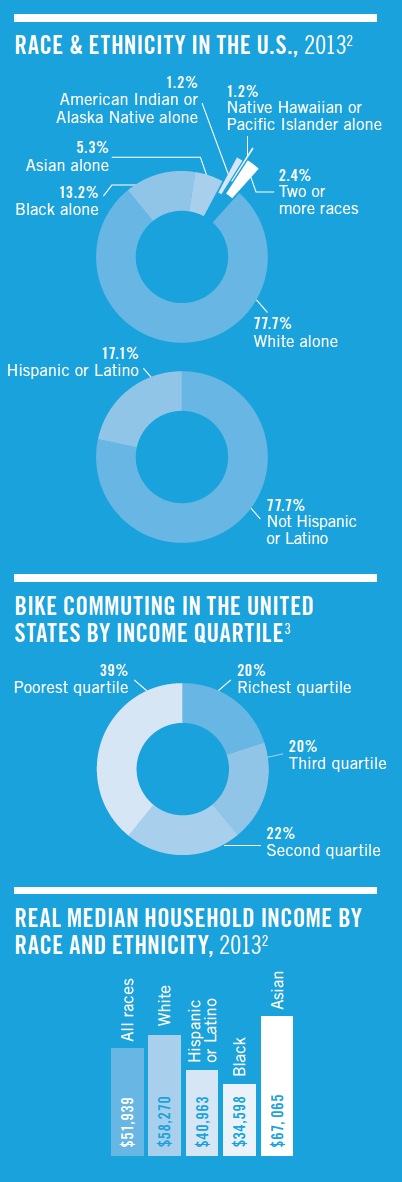PEOPLE FOR BIKES
 Diversity created the city. But diversity has never been easy.
Diversity created the city. But diversity has never been easy.
American urbanism has been a process through which communities—diverse in ideology, in interest, in income, in ethnic background and in racial identification—have negotiated space.
Some of this evolution has been brutal. Today’s cities are, among other things, the result of generations of racism and classism and struggles in the face of those discriminations. As decades and centuries have gone by, racial boundaries in the United States have shifted; discrimination has remained.
Transportation has been near the heart of that struggle from the start. From housing choice to bus frequency to freeway routing to sidewalk quality, cities have often failed to equitably distribute the costs and benefits of mobility.
Today, U.S. cities are using a new tool to help make bike transportation a mainstream part of urban American life: protected bike lanes. As this investment has taken place, city leaders and community activists have asked us for advice on how to make sure their decisions about this infrastructure don’t continue the cycle of oppression.
We all want to make sure the process of lacing green bike lanes across city maps doesn’t repeat the damage that redlining diverse communities once did.
To explore this issue, we interviewed organizers, planners, leaders and activists in communities of color around the country who are working to build connected, all-ages bike networks.
The result is a diverse range of perspectives: some conflicting, but all united in the belief that done right, great infrastructure can help create great cities.
We hope these neighborhood-level experts, along with the national and international context we provide, will give you new ways to think about these questions:
We hope these neighborhood-level experts, along with the national and international context we provide, will give you new ways to think about these questions:
- How can protected bike lanes fit into efforts to make American cities less inequitable? In what ways are they failing?
- How can city staff and advocates better infuse transportation justice into bikeway planning?
- How should bike infrastructure investments combine with other issues to diminish inequities between communities?
In the words of Memphis Mayor AC Wharton, bicycling is “for everybody, in every neighborhood.” The people on the pages that follow want to build cities that reflect this.
At PeopleForBikes and the Alliance for Biking & Walking, we believe deeply in the future of the American city. In this report, we’re proud to help spread the expertise of people who share that enthusiasm and who are at the front of the effort to make our cities better.
Complicated issues demand clear language. Here’s how we think about some key concepts in these pages.
RACE is a type of cultural and social identity. Race has no genetic basis; rather, racial identities are social constructions that have shifted over time based on context and power. But race has often been used to justify social inequalities, and racial dynamics have massive impacts on American life.
This report references four of the most common racial groups according to the U.S. Census’ American Community Survey: White, Black, American Indian and Asian. We capitalize “Black” because it’s a distinct American identity.
ETHNICITY refers to the origin of cultural and national traditions. In keeping with definitions from the U.S. Census’ American Community Survey, this report considers Hispanic / Latino origin as an ethnicity, independent of racial identification. We use “Latino” rather than “Hispanic,” except when source data does otherwise.
CLASS refers to socioeconomic stratifications beyond race, ethnicity and other factors. This report often uses household income as a proxy for class.
EQUITY is the fair and impartial distribution of resources and opportunities.
REDLINING was a practice begun in the 1930s defining acceptable areas for federal mortgage loans based on the “desirability” of neighborhoods. This triggered systemic underinvestment in neighborhoods where many Jews, Asian-Americans, Latinos, immigrants and Black people lived, leading to widespread blight in redlined communities and financial disadvantages for generations of families of color in the United States.1
PROTECTED BIKE LANES, sometimes called “cycle tracks” in the engineering world, are physically separated from automobile travel lanes by parked cars, plastic posts, concrete curbs or other materials. They are tools for making bike transportation broadly viable in auto-dominated cities.
Download full report: Race, ethnicity, class, and protected bike lanes
About People for Bikes
www.peopleforbikes.org
PeopleForBikes is the movement to make riding better for everyone. By collaborating with millions of individual riders, businesses, community leaders, and elected officials, we’re uniting people to create a powerful, united voice for bicycling and its benefits…Our goal is to make every bike ride better, whether that ride takes you on trails, down to the grocery store, or all the way across town. Why? Because when people ride bikes, great things happen for our bodies and our minds, and our local and global communities.
Tags: Alliance for Biking & Walking, Bicycling, Bike Lanes, Cycling, People for Bikes, safety






 RSS Feed
RSS Feed